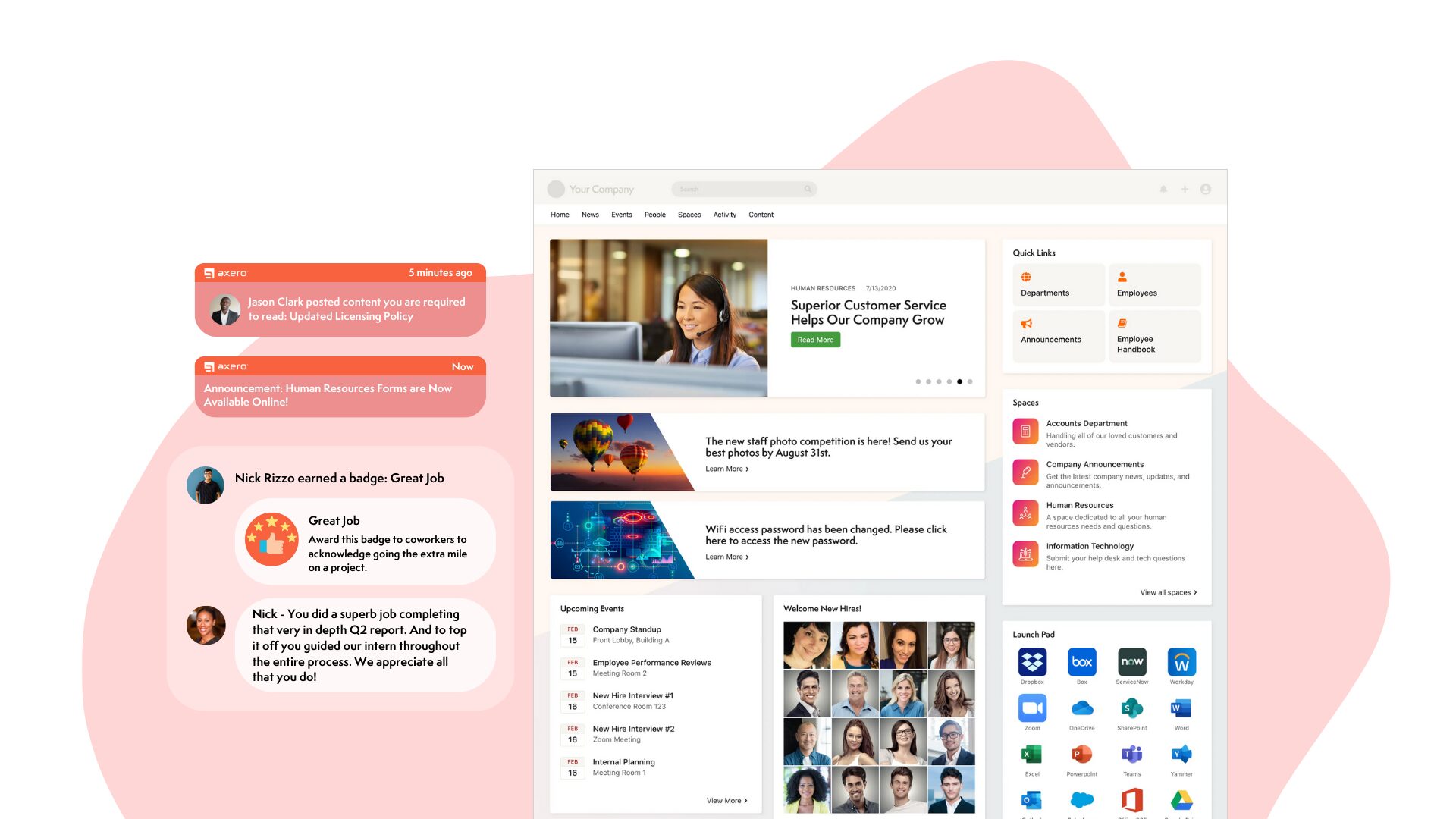Who is better to shout about the joys of your company than those who live and breathe it every day? In a world where our social media platforms are ruled by influencers and brand ambassadors, why not grab a slice of this energy for your company too?
Boosting employee advocacy is a strategy many might not think of but it can bring a wide variety of benefits to your organization. People apply for roles for a wide variety of reasons, but they ultimately want to work for a company that they know values them. The 2025 Randstad Workmonitor report discovered that, for the first time, work-life balance has overtaken compensation as more important when evaluating job offers.
If employees cannot advocate for your company, why should a stranger come aboard? Gather your advocates, support your champions, and transform your company into one everyone wants to work for.
What is employee advocacy?
Employee advocacy is the promotion and support of the company through employee own voices. If you have ever been browsing LinkedIn or other social media platforms and see a shout-out from a worker at another company, this is likely part of an employee advocacy strategy.
The content at the heart of employee advocacy can vary wildly depending on the needs of the program. Thought leadership and sharing opinions on behalf of the company can boost authority and expertise. Sharing team-building days and other fun moments helps to build community and support inclusivity. Reposting a job advert gives a thumbs up and a seal of approval from an existing team member.
These interactions do not even have to be part of a formal employee advocacy program. Ideally, you do want employees to take part as part of a structured campaign (for truly everything is part of a campaign nowadays), and the marketing and communications team will no doubt have guidance on how best to encourage employees on how to do so correctly.
However, the beauty of a successful employee advocacy program is that happy employees will engage with it without being asked. They will share the job postings and give shout-outs to their favorite managers and coworkers naturally, and you can collect the boost it will give your company.
Key benefits of employee advocacy for the organization
What can a company take from getting their employees to talk about the organization positively? There are some great benefits to doing so:
1. A boost to reach and awareness
Every time your social media posts get shared, that is a boost to your brand reach and awareness. We find so many new brands and companies to support via our social media nowadays, so it only makes sense that you try to utilize this for the company too.
Organic reach and visibility are two of the great pillars holding up company growth in all areas. Whether you are aiming for authority in your industry, a drive to recruitment, or more sales, growth can help you achieve all of these. Not every message talking about your organization needs to come from the corporate account.
2. Build your brand trust and authenticity
People like to hear from real people, especially in a saturated marketplace like a social media platform. An employee advocacy platform is great because it allows the real people who work for your company to connect with those who might be interested in what you have to offer. These connections are built on authentic interest and understanding, and their perspective is of value that cannot be dismissed in the age of artificial intelligence.
When the audience sees someone from the company sharing positive news, they believe it to be valuable and authentic so they are more likely to engage with it. The company’s messaging is giving credibility, and brand trust and authenticity rise.
3. Bring in that traffic
Did you know that employee advocacy can play a role in traffic to your website (and therefore eventually sales)? Posting to social media is a popular method for attracting interest in your website and products or services, especially if you are a B2B business posting on LinkedIn. As we mentioned above, using employee advocacy to do so gives your actions that little bit more credibility.
Leads generated from employee advocacy posts come from networks in the same media niche and industry online. They are likely to be engaged and motivated to continue down your sales pipeline because they already understand the messaging at the heart of the company.
4. Attract top talent
Of course, a company’s employee advocacy program plays a big role in recruitment and attracting top talent to available roles. Once again, when employees talk positively about a company online, this is a green flag to anyone who might be looking into the organization as part of their application process.
It is not uncommon nowadays for prospective candidates to send a quick DM to current employees on LinkedIn to get an inside scoop as to what it is like to work at the company. Here behind closed doors, they might be inclined to be more honest than if they were posting on feeds. Ideally, you want them to be both reposting and sharing their own insights about the company publicly and being enthusiastic and positive when they get these prospective messages.
5. Nurture those happy employees
Finally, if employee advocacy naturally occurs, it’s a great sign that you are doing something right in your business. You know that your team is actually satisfied and happy in their roles, not just being economical with the truth in their annual reviews, and that they are happy to recommend the organization to others both as a service and as a place to work.
When you know your employees are happy and engaged, you need to put the work in to ensure that they stay that way too. Nurture your employees and encourage them to take advantage of everything your company has to offer. Reward them with more than just a pizza party, and ensure that they always feel valued.
Key benefits of employee advocacy for your employees
Employees participating in employee advocacy will also see some benefits slide their way. Remember, it isn’t all about what the company can gain from their opinions. Employees also need to think about where they want their careers to go, and the actions they can take to elevate them to their dream position or path.
If employees choose to advocate for their company, they can enjoy the following benefits:
1. Build their own brand and reputation
Before someone is an employee, they are their own person. They may act as a representative of the organization they work for, but they also have to know how to advocate for their career and pursue their own goals. This can often mean negotiating and advocating for their reputation and interests even as they work on behalf of a specific company.
We can clearly see this when we look at the types of content posted to social media platforms like LinkedIn. Whether the post is advocating for the company or personal, we often pull from our insights and experience to create them. It is all about developing that authentic viewpoint and building expertise.
2. Give them a voice
Advocacy gives employees a voice. A company should never be this faceless conglomerate; it is made up of so many diverse people from all different walks of life. Having them act as advocates for the company gives them the opportunity to use their voices to talk about what truly matters to them.
Employee advocacy always needs to come back to authenticity. No matter whether the employee is an intern or a high-ranking member of the board, they deserve the opportunity to share their thoughts and opinions.
3. Encourage them to take a larger role in the business
Responsibility can take many forms. Sometimes, when a person wants to take a larger role in the business, they want a promotion, extra benefits, and a new set of jobs and tasks. Other times, they simply want to switch up their role a little and look for new opportunities without taking a step up the ladder.
Both can result in advocacy for the company. Employees should be offered the chance to actively shape the business’s culture as they are the ones who need to interact with and celebrate it. Taking a larger role in the business does not necessarily need to be intimidating or packed with places to trip up. Sometimes, it can just be as simple as a few posts talking about why they enjoy working for the company.
4. Guide them to new opportunities
Employee advocacy is a chance to get on the soapbox and speak to new people. As a result, some new ears may listen to what your employees have to say, and with this will come new opportunities. Some of these could be for the company, in the form of potential sales or partnerships, or it could purely be for the employee.
They could be asked to speak on podcasts or in webinars. They may be given the chance to dive into learning a new skill. They could even be offered another job. While this isn’t the most ideal situation, it has to be assumed that all employees will move on to new opportunities one day. A good company will look to nurture and support all their employees, knowing full well that they might leave them one day to work for another company and maybe even a competitor.
5. Grab more engagement and satisfaction
Happy employees mean more engagement and satisfaction, which leads to even happier employees and a nice repeating cycle where everyone can feel happy. Nominating employees to act as ambassadors for the wider company gives them the chance to express pride in the work they do.
It is all about building and nurturing that company culture after all. Ask them to consider what it is that they truly like about the company and get them to contribute towards building an inclusive and welcoming team that everyone wants to be a part of.
How do you build an employee advocacy program?
How do we go about developing our own employee advocacy program? It isn’t as simple as just asking people to start posting on social media without any clear strategy or timing. Sure, you might not want things to seem overly corporate or organized, but that doesn’t mean you shouldn’t completely swing in the other direction either. Here are some of the steps you should follow if you want to build an employee advocacy platform for your company.
1. Define your needs and goals
Any program or task at work needs to have clear goals for both the company and the individual employees supporting this initiative. Without clarification on what the program is to achieve, any passion for the project will fizzle out and be left to just drift without direction.
What is it exactly that you wish to see from your employee advocacy plan? Is it leads? A recruitment drive? A bump in followers on your social media accounts?
Whatever it might be, you need to have a plan and a goal in place so you can get the right employees involved with your efforts. Any employee advocacy work that takes place needs to match the goals you have in mind, otherwise you will not achieve the results that you wish to see.
2. Implement a tool
As with many other aspects of business, everything is a little better when you use the right tool. Finding a dedicated employee advocacy software or tool means that all information regarding the program can sit in the same place. Whether you are trialing employee advocacy tools or just trying to pull together everything into one platform for ease of access, it just makes sense to have everything in one platform.
With tools such as these, make sure that they can integrate well with your company intranet. All communication content ideally wants to come in or out of this hub, and all information about certain projects should be easily accessible here. Modern intranet like Axero is designed to be as flexible as possible, so you should have no trouble integrating your chosen employee advocacy tool into the platform to use alongside your others.
3. Support employees
Employees participating in your advocacy program should not just be launched onto a social media network with no game plan and no idea as to how to proceed. Some will be very comfortable hopping on their personal social media accounts to talk about the company, while others might need a little more guidance.
For this reason, you may want to offer employee advocacy training to your brand advocates to help them master best practices. This can also help to establish set guidelines and standards to ensure that all content shared meets the needs of the business and the advocacy strategy.
4. Provide content and tips
In line with providing support to employees, managers need to consider the content that the company wishes to provide to its advocates. After all, this is about developing the employer brand as much as that of the employee. Using a unifying metric such as the same company content can help create an overarching message between all accounts and also just give the employee a helping hand.
They have a full roster of tasks that they need to get on with, so why should they also have to sit down and plan out a social media strategy for this additional task? The marketing and/or corporate comms department should work to create a content calendar filled with different posts. Some will be more formal, like sharing company news or opinions on policies and developments, and some will be simple pictures or even a gif with a witty caption. No matter how complex or simple the post might be, a little extra support will never go amiss.
5. Recognize and reward your top advocates
Who are the people showing up on their personal networks? Who are the ones actually putting the time and effort into consistently posting and advocating on behalf of the company? The right employee advocacy platform and program will also have rewards in place to celebrate and recognize those who consistently and authentically talk about the company.
Make sure this isn’t just a volume thing. Employees should gain recognition for their employee advocacy efforts, whether they are posting regularly or just pulling together one singular post that gains a lot of traffic and interest. Don’t just keep it focused on employee advocacy, but roll out a full recognition program and work on boosting employee engagement across multiple areas; it can all feed back into the advocacy plan.
How to tell if your employee advocacy program is successful
So, you have put in all this work to build the company’s own advocacy program, and posts are now rolling out across employee networks. Sure, the posts are getting interest, but can you tell if the program is actually successful or not?
Remember, you should have set some goals for the program back when you decided to build it. Whether you are looking to pick up web traffic, grow your reach and impressions, or even just boost satisfaction among employees, these goals and KPIs will be crucial in helping you establish your success.
Ideally, you need to record these goals and their respective metrics in one location, which is easily accessible to everyone who needs to see that data. And what better place is there than that hub you have already set up in your company intranet?
Tracking metrics and data is a crucial part of any initiative at work, but it becomes even more important when you want to see a marked improvement in a specific area. Though employee advocacy carries a wide range of benefits for both the company and the employees, the good can fall short if you don’t know how it is taking place. Any bumps that emerge in the road can be smoothed out so the program only goes from strength to strength.
Build employee advocacy for your organization today
Employee advocacy is great for everyone. Not only does it boost your company, but it also gives the perfect platform for your workers to grow from. If you want to provide an honest glimpse into the life of your team, employee advocacy can be a much better pathway than other forms of corporate communications.
Processes like this should not be scattered across multiple software and are impossible to track down. All relevant information needs to be in one place and easy for users to find. Though employee advocacy should be authentic, a guiding hand behind can ensure that everything stays on message and up to standards.
Whether you are engaging in employee advocacy, streamlining internal communications and knowledge sharing, or simply looking for a new way to say hi to the team in the morning, consider using a purpose-built company intranet like Axero. Our platform is designed to be as flexible as possible, allowing you to add the functionalities your team needs for the greatest success.
Book a demo with us today, and find out how Axero can transform the way you handle your business. Who knows, it could become a great talking point for your advocates!


















 info@axerosolutions.com
info@axerosolutions.com 1-855-AXERO-55
1-855-AXERO-55


